CAMPELLO SUL CLITUNNO
Territory
Located in the central-eastern part of Umbria, the Municipality of Campello sul Clitunno mostly occupies an irregular jagged area on the western side of the Umbria-Marche Apennines and a limited band of flat land at the foot of the mountain, a small part of the vast Spoletina Valley or Plains.

The municipal area has a small flat area and a large hilly and mountainous area. The various morphological aspects of the land provide various landscapes: from the flat plains with the Marroggia river and the exceptional presence of the Springs of Clitunno; the low hills with their medieval castles and Franciscan hermitages, that are distinguished by the olive groves on the terraces built in dry stone walls so typical of Campello; as far as the mountain region, where woodland and pasture land dominates the scenery (woodland areas cover 80% of the municipal territory).

The morphological variability and the vegetation covering the area make it an important natural landscape where the built-up areas are limited and mainly constituted by ancient buildings. The wealth of the landscape is underlined by the thick network of pedestrian paths, donkey-tracks and lanes that thread through the entire area, allowing even the wildest and characteristic sites to be used in a particular manner.
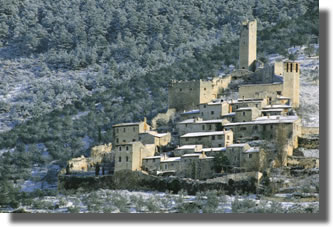
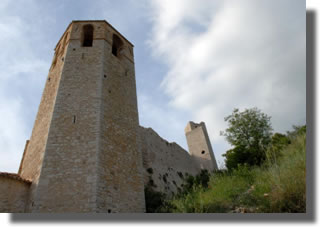
Pissignano and the castle’s tower
On the slope of the hill above the Clitunno Tempietto and the Springs of the Clitunno stands the Castle of Pissignano, 11th century. The perimeter of its walls is still undamaged and is alternated by polygonal towers and by two gate-towers, which provided access to the village and the fortified donjon.
The ancient pavements made of river pebbles and bricks, the houses leant one against the other and the ancient municipal small palace of the 15th century are really characteristic.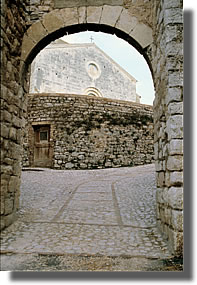
The castle has a triangular shape, a typical shape of the hillside castle, having the top up the hill and the towers at the corners and on the two sloping sides in an intermediate position. The top tower is very high and slim; however, the most important defence functions were surely concentrated in the intermediate pentagonal tower, utilized since ancient times as a bell tower and apse of the Church of S. Benedict. The houses rearranged in sloping terraces and, partially, still have medieval features.
From the Castle of Pissignano, along a path through the olive trees, it is possible to reach the Franciscan Hermitage that dominates the hill of St. Benedict, a real haven of peace and tranquillity through the woods. Inside the enclosure, on a rock, stand the remains of an impressive Sillian tower and the small church with a small 15th century cloister.
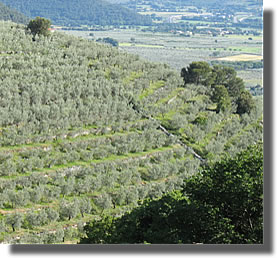
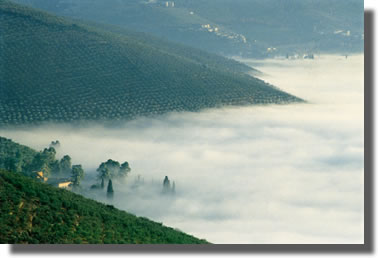
The hermitage, named after St. Anthony the Abbott, is dated back to the year 1000. The first sure information dates back to the 14th century. By 1370 it was inhabited by Franciscan Friars and it seems that San Francesco visited it. Surely, St. Bernardino of Siena lived there and from there evangelized the Umbra Valley.
The tradition tells that already in the 5th century the cave where the hermitage stands received hermits coming from Syria and Egypt like the other caves of the area.
At present it receives visitors and pilgrims and offers listening service, human and sympathetic welcome to whom asks for support or advice and particularly wants to be helped in a path of reconciliation and research of the peace with him/herself and the others.
Just one hundred metres from the Springs of Clitunno, along the Via Flaminia, there are the ruins of the Romanesque church of Santi Cipriano e Giustina, built in the 11th-12th centuries in honour of the Bishop Cipriano. It belonged to Benedictine monks and was the parish church for several villages spread in the foothills of Campello.
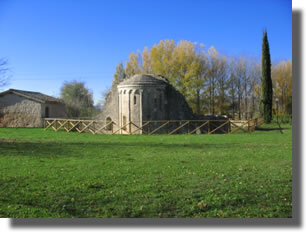
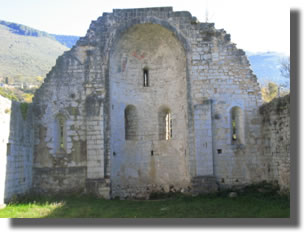
The perimeter walls and the apse wall of the old church can still be seen. The single nave church was completely covered with Giotto-style frescoes from the 14th-15th centuries, of which only faint traces can now be seen.
The Church ruins, covered for decades by thick vegetation and almost all underground, were brought to light and restored by the Mountain Communities of the Monti Martani e del Serano in 1995. The architectural restoration of the apse was supervised by the Superintendence for environmental, architectural, artistic and historical heritage of Umbria.
Near the Church of S.S. Cipriano e Giustina, there is also a small church, the Church of San Sebastiano, which was built in the early 16th century with the money of the local community as a “ex voto” for the ceasing of a plague epidemic.
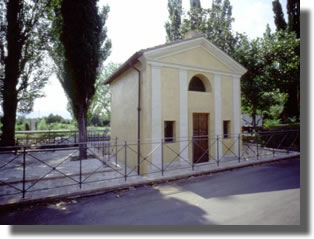
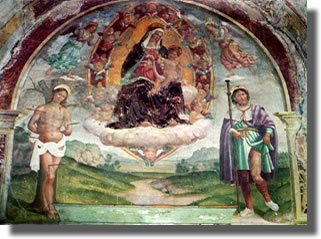
Inside it was entirely covered with religious paintings showing Saint Sebastian, traditionally called upon, together with Saint Rocco, against plagues. “La Madonna con il Bambino in gloria e i SS. Sebastiano e Rocco” on the back wall is one of the last works by Giovanni di Pietro, known as “lo Spagna”, who in 1528, helped by his son-in-aw Jacopo Siculo, left the delicate new fresco on the wall, in a style that, while less sophisticated, reminds one of Raffaello’s style, who was a companion of his at the school of the Perugino. The Church façade dates back to the late 18th century, similar in form to Valadier’s style, who worked in this area in the same period.
The town of Campello su Clitunno, now the Municipal centre, was built around the Sanctuary called Santuario della Madonna della Bianca, built in the 16th century. The Church, which still has the important door built by Maestro Cione da Como; the interior, designed by Valadier, is decorated with 17th century canvases and Renaissance frescoes by Angelucci and Spagna.
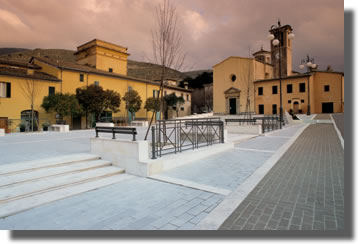
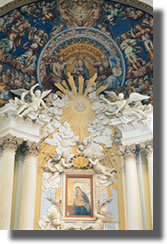
Campello. The main square and the Madonna della Bianca Sanctuary
There are also interesting centres along the mountain ridge, including the villages of Acera and Spina, charming medieval villages that are hidden by the surrounding woodland.
The Castle ofCampello Altois an especially interesting and charming site. On top of a hill full of olive trees, it still has its powerful defence walls, the large entrance gate, the romanesque Church of San Donato and the 16th century Municipal Palace.
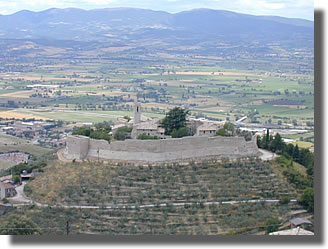

Campello Alto
The Barnabiti Monastery, is close to the castle. Inside there are several medieval and Renaissance artistic finds, such as two Giotto-style frescoes and a Madonna by lo Spagna.
In the area of Lenano, located on the road from Spoleto to Castello di Campello, one finds a Church dedicated to San Lorenzo, a rural chapel from the romanesque period. The oldest layer of frescoes on the back wall, only visible through the missing fourteenth century plaster, can be dated back to the second half of the 12th century, while the latest one, now preserved, dates back to the 14th century.
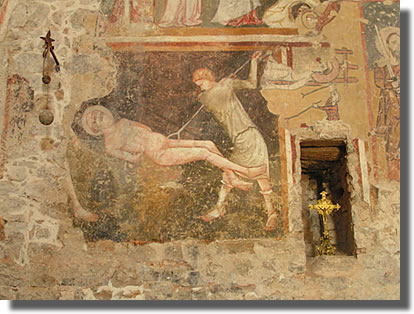
Fresco inside the San Lorenzo Church
In addition to the heritage of the site and the buffer zone, the territory of Campello appears to be especially rich in architectural sites that mix with the other natural, agricultural-food, productive/craftwork and socioeconomic aspects and potential of the region.


